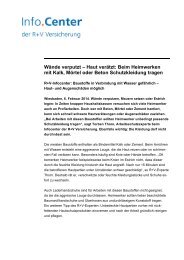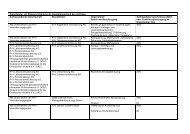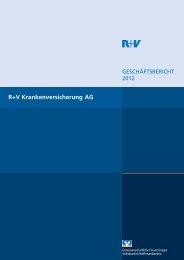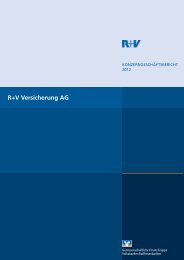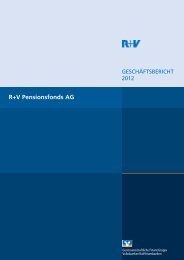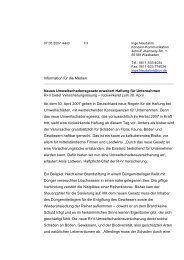Weather Derivatives - R+V Versicherung
Weather Derivatives - R+V Versicherung
Weather Derivatives - R+V Versicherung
Create successful ePaper yourself
Turn your PDF publications into a flip-book with our unique Google optimized e-Paper software.
<strong>Weather</strong> <strong>Derivatives</strong><br />
The challenge of managing weather risk in<br />
renewable energy<br />
Teresa Schorstein<br />
26. September 2012
Table of Contents<br />
1) About CelsiusPro<br />
2) Climate Change and Environmental Stress<br />
3) <strong>Weather</strong> <strong>Derivatives</strong> at CelsiusPro<br />
4) <strong>Weather</strong> Risk Management Market<br />
5) <strong>Weather</strong> <strong>Derivatives</strong> and Renewable Energy<br />
2
Part 1<br />
About CelsiusPro<br />
3
Profile<br />
� CelsiusPro AG: Swiss based, Founded 2008, 6 Employees<br />
� CelsiusPro Australia Pty Ltd: Founded 2012, 4 Employees<br />
� Industry: <strong>Weather</strong> Risk Management<br />
� Product: Tailored <strong>Weather</strong> <strong>Derivatives</strong> (OTC Options)<br />
� Strategic Partnership: Swiss Re<br />
� Association: <strong>Weather</strong> Risk Management Association (WRMA)<br />
� Award: 2009 Swiss Insurance Industry Award for Innovation<br />
4
About CelsiusPro<br />
What we do:<br />
� Enable companies to hedge themselves against financial losses due<br />
to adverse weather<br />
� Provide liquidity and transparency to the weather market<br />
� Educate industries in quantifying weather risk<br />
� Reduce the complexity for clients to do weather derivative<br />
transactions<br />
5
Countries and <strong>Weather</strong> Stations<br />
6
Part 2<br />
Climate Change and Environmental Stress<br />
7
Climate Change - Trends<br />
IPCC identifies three major effects of<br />
climate change on extreme weather:<br />
Trend of:<br />
� Warmer temperatures<br />
� More extreme temperatures<br />
� Heavier precipitation<br />
� Longer droughts.<br />
Source: IPCC, Intergovernmental Panel on Climate Change<br />
8
Source: National Oceanic and Atmospheric Administration (NOAA)<br />
Temperature<br />
Earth’s overall temperature has increased<br />
by 1.3°F (0.7°C) since 1900. In the graph,<br />
average annual surface temperature is<br />
shown as the difference from the average<br />
for 1901-2000.<br />
Glaciers<br />
Since 1980, a representative set of well<br />
studied glaciers has lost the equivalent of<br />
40ft.(12.5m) of water on average. The<br />
graph shows the average mass balance of<br />
30 reference glaciers around the world.<br />
Spring Snow Cover<br />
Earlier melting of winter snow has reduced<br />
the area of land covered by snow in<br />
spring. The graph shows the area covered<br />
by snow in the N. Hemisphere during<br />
March and April, shown as the difference<br />
from the 1971-2000 average.<br />
9
Source: National Oceanic and Atmospheric Administration (NOAA)<br />
Ocean Heat<br />
More than 90% of the warming that has<br />
occurred on Earth over the past 50 years<br />
has occurred in the ocean. The graph<br />
shows heat energy in the top 700m of the<br />
ocean as the difference from the average<br />
from 1955-2006.<br />
Sea Level<br />
The average height of the ocean’s surface<br />
has increased by 8.25”(210 mm) since<br />
1880. The graph shows mean global sea<br />
level measured by tidal gauges since 1880<br />
and by satellite instruments since 1993.<br />
Arctic Sea Ice<br />
The area of the Arctic where sea ice<br />
remains frozen at the end of summer has<br />
decreased by more than 10% per decade<br />
since 1979. The graph shows the average<br />
area with at least 15% sea ice on its<br />
surface each September.<br />
10<br />
Source: NOAA
Part 3<br />
<strong>Weather</strong> <strong>Derivatives</strong> at CelsiusPro
<strong>Weather</strong> <strong>Derivatives</strong><br />
Characteristics:<br />
� European style capped option on climate parameter<br />
� Cash settled<br />
� Based on the measurements of the national meteorological office<br />
Defined by the following attributes:<br />
� <strong>Weather</strong> Station<br />
� Contract Period<br />
� <strong>Weather</strong> variable or underlying<br />
� Index which aggregates the weather variable<br />
� Payoff function, which converts an index into the cash flow<br />
� Premium<br />
13
<strong>Weather</strong> Indices / Difference to Insurance<br />
Typical weather variables are:<br />
� Daily Temperature (average, maximum or minimum)<br />
� Rainfall or Snowfall / Snow depth<br />
� Wind, Carbon Dioxide, Pressure, River Flow, Sun Radiation, Waves Height<br />
� Hourly Rainfall (or other hourly weather)<br />
The underlying weather measurements are aggregated with a function to a<br />
weather index.<br />
The key differences between weather derivatives and insurance:<br />
� <strong>Weather</strong> derivatives are financial contracts and not insurance contracts.<br />
� No proof of losses or damages are required.<br />
� The payout is not in relation to losses or damages but solely to the values<br />
measured at the weather station (index based).<br />
14
<strong>Weather</strong>-Sensitive Industries<br />
� Transportation<br />
� Utilities<br />
� Travel and Leisure<br />
� Construction/Mining<br />
� Events<br />
� Retail and Wholesale<br />
� Agriculture<br />
� Marketing<br />
� Renewable Energy<br />
15
How it works<br />
� Linked to measurements of a particular<br />
weather station.<br />
� The national meteorological office<br />
delivers the values<br />
� At expiry of the certificate the contract is<br />
settled and paid out<br />
Budapest:<br />
WMO Nr. 12843<br />
Lat. 47.43<br />
Lng. 19.8<br />
Alt. 138<br />
16
<strong>Weather</strong> <strong>Derivatives</strong> Terminology<br />
1. The <strong>Weather</strong> Station is the official measurement station which is used for<br />
price calculation and settlement.<br />
2. The period between the Start Date and the End Date is the Risk Period. Start<br />
and End Dates are always included.<br />
3. The Threshold defines when a day counts as a Critical Day.<br />
4. The Strike defines the amount of Critical Days of own risk. The Payout per<br />
Critical Day starts only once the number of Critical Days counted during the<br />
risk period exceeds the Strike value.<br />
5. The Payout per Critical Day is the amount paid for every Critical Day in<br />
excess of the Strike.<br />
6. The Maximum Payout is the payout limit of the certificate. It is usually a<br />
multiple of the Payout per Critical Day.<br />
17
Contract Example: Rain Day (1/3)<br />
Risk period und location<br />
� Period: 01.03.2011 –07.03.2011 (7 days)<br />
� <strong>Weather</strong> station: Frankfurt Airport<br />
<strong>Weather</strong> index definition<br />
� Certificate type: Rain Day (Call)<br />
� Threshold: > 5mm per day<br />
Payout definition<br />
� Strike: 2 Rain Days<br />
Payout size definition<br />
� Payout per Rain Day: EUR 10‘000<br />
� Maximum Payout: EUR 50‘000<br />
60.000<br />
50.000<br />
40.000<br />
30.000<br />
20.000<br />
10.000<br />
Premium: EUR 4‘012 0<br />
Payout in EUR<br />
Payout Profile<br />
0 1 2 3 4 5 6 7<br />
Rain Days at Expiry<br />
18
Contract Example: Rain Day (2/3)<br />
<strong>Weather</strong> derivatives are index based products.<br />
Example: Rain Day Certificate<br />
Pays out a pre-defined amount for every day the daily rainfall is above 5mm.<br />
� Index: Number of Rain days > 5mm<br />
Rainfall measurement:<br />
Payout calculation:<br />
(Index –Strike) * Payout per Rain Day<br />
(4 –2) * 10‘000 = 20‘000<br />
19
Contract Example: Rain Day (3/3)<br />
Strike<br />
normally set between average (At-the-Money) and average + 1.5 StDev (Out-ofthe-Money).<br />
Maximum Payout<br />
is the product of: (Payout per index point * (Exit-Strike)). The exit is normally set<br />
as historical extreme or average + 3-4 StDev.<br />
Cover<br />
Example:<br />
Payout per Rain Day: EUR 10‘000 *<br />
(Exit: 7 Rain Days –Strike: 2 Rain Days)<br />
= Max Payout: EUR 50‘000<br />
Strike Exit<br />
20
Part 4<br />
<strong>Weather</strong> Risk Management Market
<strong>Weather</strong> Risk Management Market<br />
Market:<br />
• First <strong>Weather</strong> <strong>Derivatives</strong> were used in 1997<br />
• Launch at CME in 1999<br />
Volume:<br />
• Number of traded contracts, futures and OTC options rose 35% from<br />
2007 to 2008 from 730,000 to 985,000<br />
• Nominal value of traded contracts rose 68% from USD19bn to USD32bn<br />
Geography:<br />
• Starting from the USA to Canada, Europa and Japan<br />
Products:<br />
• Variety has increased strongly from temperature-based to precipitation,<br />
snow and even hurricane<br />
22
Traded @ Product Description<br />
Exchange Industry Loss Warranties<br />
Hurricane Futures & Options<br />
Hurricane Landfall Options<br />
<strong>Weather</strong> <strong>Derivatives</strong><br />
OTC CAT Bonds<br />
<strong>Weather</strong> <strong>Derivatives</strong><br />
IFEX - The buyer selects …<br />
� Insured event (e.g. tropical wind)<br />
� Trigger in total industry loss units (Industry Loss Index<br />
provided by PCS)<br />
� CME Hurricane Index (CHI ) measures the<br />
potential damage from a hurricane by reference to its<br />
maximum wind velocity and size<br />
� Binary options are used in the same way as the<br />
Industry Loss Warranties<br />
� Call options on whether and where a hurricane will<br />
make first landfall on the U.S. Atlantic and Gulf coasts<br />
� National Hurricane Center determines whether a storm<br />
made landfall as a hurricane<br />
� Premiums aggregated into mutual risk pool<br />
� Payout is pro rata share of the pool<br />
� Products are only available for major cities in the US<br />
� Selected indices (HDD, CDD, frost, snowfall, rainfall)<br />
� alternative to traditional reinsurance,<br />
� event triggered by natural catastrophe<br />
� insurance company issues bonds (through) investment<br />
bank<br />
� no-event situation: Insurance company pays coupon to<br />
investors<br />
� event situation: principal is forgiven, money used to<br />
pay claims<br />
� location- specific products available<br />
� indices tailored to individual company’s weather<br />
exposure<br />
23
Convergence of Re Insurance and Capital Markets<br />
Competitive landscape in the weather risk business.<br />
Local Banks<br />
Insurance Markets Banks<br />
Offer limited products upon Capital Markets<br />
Lloyds Offers weather solutions mainly<br />
to large events, don’t offer solutions for<br />
many other sectors.<br />
National Hail Insurance offer hail cover<br />
and drought covers.<br />
AON, March Large international<br />
insurance broker across all<br />
insurable risk categories.<br />
XL Insurance Used to be big in<br />
weather but reduced business<br />
after subprime losses.<br />
Swiss Re Largest weather risk capacity.<br />
Munich Re Largest Reinsurance company,<br />
weather strategy unclear<br />
Nephilia risk capacity <strong>Weather</strong> Bill,<br />
Bermuda based<br />
Insurance<br />
Brokers<br />
AON<br />
March<br />
XL Insurance<br />
Re Insurance<br />
Swiss Re<br />
Munich Re<br />
Renaissance Re<br />
Ren Re<br />
Nephilia<br />
Insurance<br />
Lloyds<br />
National Hail<br />
Insurance<br />
<strong>Weather</strong><br />
Risk<br />
Hypo Vereins.<br />
Hypo Tirol<br />
Bayrische<br />
Exchanges<br />
LB<br />
<strong>Weather</strong> Risk<br />
Specialists<br />
Galileo<br />
<strong>Weather</strong> Bill<br />
New <strong>Weather</strong> Risks<br />
CelsiusPro (CP)*<br />
MSI Guaranteed <strong>Weather</strong><br />
CME, Eurex<br />
request<br />
Hedge Funds<br />
Cumulus, Coriolis,<br />
D.E. Shaw, Tudor,<br />
PCE Investors<br />
Commodity Broker<br />
ICAP, TFS,<br />
Evo Markets,<br />
CBS AU*,<br />
DCA NL*<br />
Chicago Mercantile Exchange<br />
Offer limited products and stations including<br />
snowfall HDD, CDD, CAT.<br />
Eurex Offer only hurricane products.<br />
Cumulus , Coriolis, <strong>Weather</strong> specialist HF<br />
D.E. Shaw, Tudor Large international HF<br />
dealing across all asset classes<br />
Commodity Broking Services (CBS)<br />
Australian partner company of CP,<br />
DCA Dutch partner company of CP,<br />
ICAP, TFS Large international broker across all<br />
asset classes<br />
<strong>Weather</strong> Bill Hourly Contracts, Online Pricer, backed<br />
by Nephilia<br />
New <strong>Weather</strong> Risks UK partner of WB<br />
Galileo Hourly Contracts, Swaps and Collars, no<br />
Online Pricer<br />
MSI Guaranteed <strong>Weather</strong> World wide weather<br />
stations, Homepage is complicated<br />
24
Part 5<br />
<strong>Weather</strong> <strong>Derivatives</strong> and Renewable Energy
Wind Energy –CP Wind Index (1/3)<br />
� Replicates the slope of the power curve<br />
� Serves as a good proxy for hedging production risk<br />
� Established by using 1 kWh as 1 index point<br />
� Approximates the power curve of a 2MW turbine.<br />
m/s CP Wind Index<br />
0 0<br />
1 0<br />
2 20<br />
3 50<br />
4 100<br />
5 200<br />
6 400<br />
7 600<br />
8 800<br />
9 1,000<br />
10 1,200<br />
11 1,400<br />
12 1,600<br />
13 1,800<br />
14 1,900<br />
15 2,000<br />
16 2,000<br />
17 2,000<br />
18 2,000<br />
19 2,000<br />
20 2,000<br />
26
Wind Energy –CP Wind Index (2/3)<br />
Correlation: The graph shows the<br />
correlation between the monthly<br />
power production and the monthly CP<br />
Wind Index at the station Aberdeen.<br />
Production (KwH)<br />
16500000<br />
14500000<br />
12500000<br />
10500000<br />
Correlation Production vs CP Wind Index<br />
8500000<br />
6500000<br />
4500000<br />
2500000<br />
1 3 5 7 9 11 13 15 17 19 21 23 25 27 29 31<br />
Month<br />
14000<br />
12000<br />
10000<br />
8000<br />
6000<br />
4000<br />
2000<br />
Production CP Wind Index<br />
CP Wind Index<br />
Regression: The graph shows the<br />
regression between the monthly<br />
power production and the monthly CP<br />
Wind Index at the station Aberdeen.<br />
CP Wind Index<br />
14000<br />
12000<br />
10000<br />
8000<br />
6000<br />
4000<br />
Regression Production vs CP Wind Index<br />
y = 0.0008x + 560.7<br />
R² = 0.8285<br />
2000<br />
2500000 7500000 12500000 17500000<br />
Production (KwH)<br />
27
Wind Energy –CP Wind Index (2/3)<br />
Payout Profile<br />
Period: 01.01.2013 - 31.03.2013<br />
Strike: 7,500 CP Wind Index Points<br />
Tick: EUR 10 / CP Wind Index Point below 7,500<br />
Maximum Payout: EUR 550,000<br />
Payout in EUR<br />
60.000<br />
50.000<br />
40.000<br />
30.000<br />
20.000<br />
10.000<br />
0<br />
Payout Profile: CP Wind Index Put Option<br />
Number of CP Wind Index Points<br />
Option Payout<br />
28
Hydro Power –Dry Season Certificate (1/2)<br />
Hydro Power Producers are dependent on sufficient precipitation.<br />
To hedge against the risk arising from below average precipitation Hydro<br />
Power Producers use Dry Season Certificates<br />
Cumulative Precipitation in mm<br />
900<br />
800<br />
700<br />
600<br />
500<br />
400<br />
300<br />
Cumulative Precipitation 1. May - 31. October<br />
2009 2008 2007 2006 2005 2004 2003 2002 2001 2000<br />
Cumulative Rainfall<br />
29
Hydro Power –Dry Season Certificate (2/2)<br />
Payout Profile<br />
Period: 01.10.2013 - 31.10.2013<br />
Strike: 530 mm<br />
Tick: EUR 5,000<br />
Maximum Payout: 1,000,000 Payout in EUR<br />
Payout in EUR<br />
€1.200.000<br />
€1.000.000<br />
€800.000<br />
€600.000<br />
€400.000<br />
€200.000<br />
Payout Profile: Dry Season Certificate<br />
€0<br />
290 310 330 350 370 390 410 430 450 470 490 510 530 550 570<br />
Cumulative Precipitation in mm<br />
30
Many thanks for your attention!<br />
Teresa Schorstein<br />
Business Development & Third Party Sales<br />
(+41) 44 205 99 13<br />
teresa.schorstein@celsiuspro.com<br />
www.celsiuspro.com<br />
31




